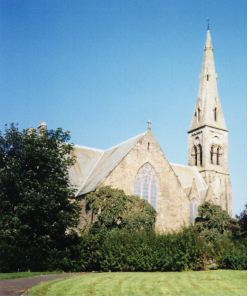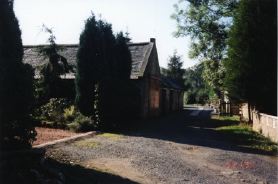
Dalry is situated in eastern Ayrshire, southwest of Glasgow, and lies northeast of Prestwick roughly on a line from the airport to the great city. Dalry is comes from the Gaelic Dail-righ, which signifies the "King's Valley". The parish is about ten miles in length and varies from three to eight milses in breadth. The valley as the name inplies is the distinguishing feature of the parish. It is both fertile and beautiful. The ground rises gradually on both sides. The river Garnock flows through the parish for about seven miles, in the course of which it is joined by the Caaf and Rye, and several other tributaries.
Eighteenth century writers noted that Dalry had long been noted for the excellence of its dairy, and the attention that had been given to improve the tillage and practice of agriculture in the parish. The rich peaty soil was excellent for agriculture. By mid 18th century, there had been extablished various limeworks, a number of coal pits and an open pit iron mine.
Dalry is first mentioned in 1226 as a "chapel of Ardrossan". If the parish was not formed at that date, it surely was by 1279 when a certain "Henry, Rector of the Church of Dalry" appears in the Register of the Diocese of Glasgow. There appear to have been two places of worship in the parish by the late 13th century. One was on the east bank of the River Garnock at Kilcush, and th other on the west, sidtuated "near to ground called 'the Old Glebe'". The latter appears to have been the main, or parish church; though it would have been a small simple building probably with an earthen floor, thatched roof and a few windows. This church building was almost certainly dedicated to ST. MARGARET OF ANTIOCH, a virgin martyr of the 3rd or 4th century

Dalry was non-existent as a village until a "kirktoun" grew up around the new parish church, built in 1604. The Kirk essentially "made" the village. By 1700 the inhabitants of Dalry still however, numbered barely 100. The original church was rebuilt in 1771. By the mid 18th century, Dalry was still the only town in the parish, standing on the banks of the Garnock, the Caaf and the Rye. It consisted at that time of only five streets. It boasted of several "excellent" stone buildings, ans shops of quite a metropolitan appearance. Weaving was the chief employment of the population. Between 1871 and 1873 the present "St. Margarets was constucted, presenting the village with a Victorian gothic cruciform building. Its 159 foot clock tower is still the most sistinct feature of the village.
The register of births and marriages commences in 1683, but was not regularly kept until 1724. By the acts of the kirk-session, the observance of the Sabbath was stricly enforced, and the usual strict measures were persued against those guilty of immoral conduct. The session minutes do not go back far enough to record those strange cases of witchcraft for which Dalry was somewhat famous.
 Drop us a line!
Drop us a line!
| Harveys | Origins | Planters | James | Archibald | Robert | |
| Little Arch | Joseph | Everett | Orace | Bruce | Christine |